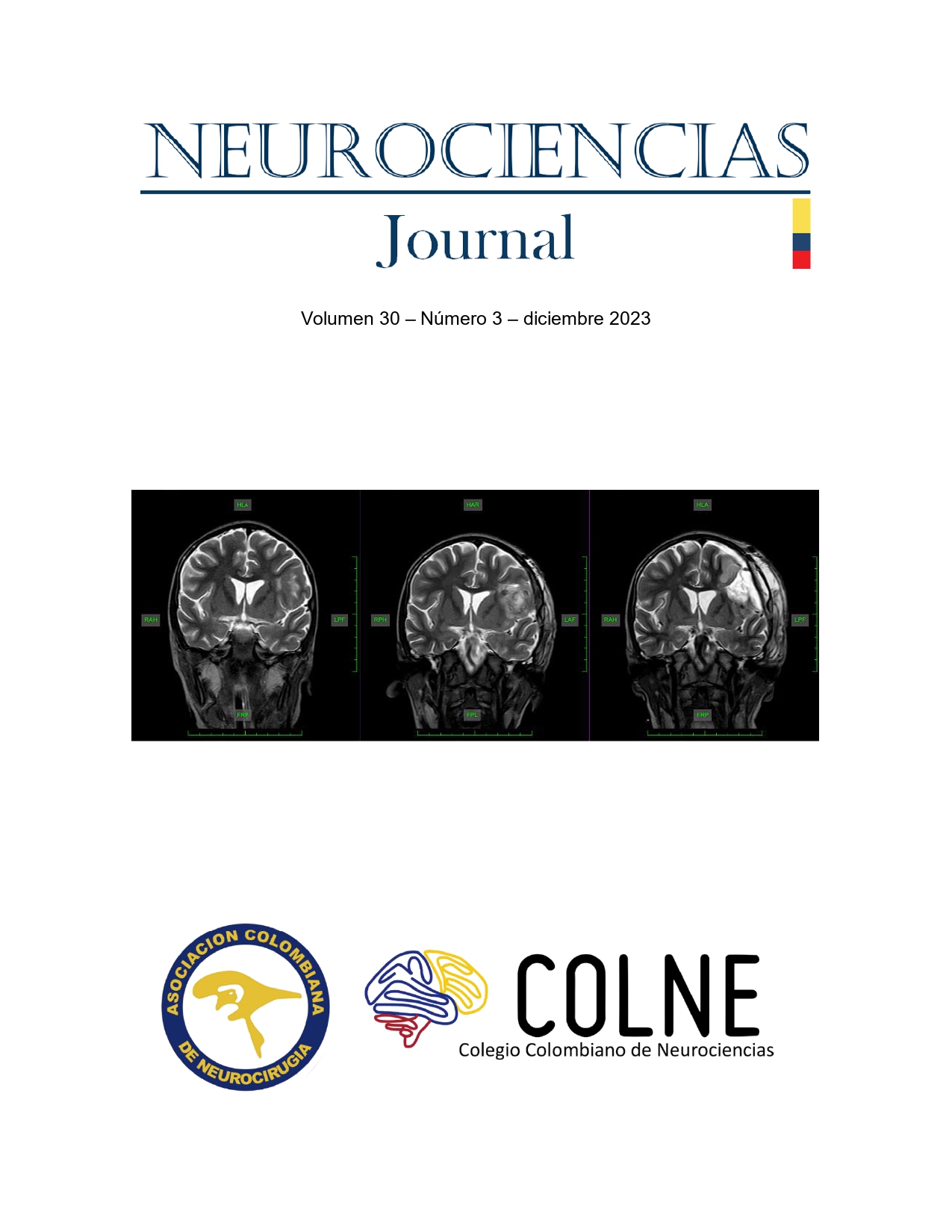LESIÓN TRAUMÁTICA DE C2 SOBRE DEFECTO CONGÉNITO VERTEBRAL -REVISIÓN NARRATIVA Y REPORTE DE CASO-
DOI:
https://doi.org/10.51437/nj.v30i3.414Palabras clave:
Defecto congénito, déficit neurológico, unión atlanto-axial, fracturaResumen
Introducción: Las lesiones traumáticas de la columna cervical asociadas a defectos congénitos son infrecuentes y subdiagnosticadas, además poco documentadas en la literatura médica. Lo que limita la creación de estándares terapéuticos para ofrecer a estos pacientes, llevando a que la toma de decisiones sea basada primordialmente en la opinión de expertos. Se presenta entonces el caso de un paciente con defecto congénito de columna cervical asociado a trauma.
Presentación del caso: Paciente masculino de 34 años, sano, quien cursa con un politraumatismo en accidente de tránsito; posterior a lo cual debuta con cefalea y cervicalgia, en relación con un defecto congénito de la segmentación del arco posterior de C2-C3, asociado a una fractura de la pars de C2 (Fractura AO unión C1/C2 tipo C), con inestabilidad segmentaria; en paciente neurológicamente indemne. Fue remitido antes de su tratamiento definitivo
Conclusión: Escasa información en la literatura respecto a patologías infrecuentes aumenta el grado de dificultad en la toma de decisiones. Por lo que se presenta este estudio, con el fin de motivar a una re-colección amplia de casos con los que se pueda generar descripciones y seguimiento en el tiempo, así como la evolución de los pacientes, para brindar herramientas que aporten estudios de mayor poder estadístico, que puedan orientar la toma de conductas de tratamiento, el estudio de esta patología y sensibilizar sobre el riesgo de déficit neurológico en aquellos pacientes con antecedente de defectos congénitos.
Citas
Menezes AH. Developmental abnormalities of the cranio-vertebral junction., In: Youmans and Winn. WB Saunders ed. Youman’s Neurological Surgery. 5th ed. Philadelphia; 2003. pp: 3331–3345.
Gasser RF. Early formation of the basicranium in man. In: Bosma JF, ed. Symposium on Development of the Basicranium. Bethesda, MD: Department of Health Education and Science; 1976. pp 29–43
Müller F, O’rahilly R. The human chondrocranium at the end of the embryonic period, proper, with particular reference to the nervous system: CHONDROCRANIUM OF HUMAN EMBRYO. Am J Anat. 1980;159(1):33-58.
Menezes A. Congenital and Developmental Anomalies of the Craniovertebral Junction. In: Goel, Atul. II. Cacciola, Francesco. Thieme ed. Atlanto-occipital joint Surgery. 1st sd. New York. 2010. pp 71-82
Menezes AH. Embryology, development and classication of disorders of the craniovertebral junction. In: Dickman CA, Sonntag VKH, Spetzler RF, eds. Surgery of the Cranio-vertebral Junction. NY: Thieme. 1998. pp 3–12
Keynes RJ, Stern CD. Mechanisms of vertebrate segmentation. Development. 1988; 103(3):413–429
Menezes AH. Evaluation and treatment of congenital and developmental anomalies of the cervical spine: invited submission from the Joint Section Meeting on Disorders of the Spine and Peripheral Nerves. J Neurosurg Spine. 2004; 1(2):188–197
Dietrich S, Kessel M. The vertebral column. In: Thorogood P, ed. Embryos, Genes and Birth Defects. Wiley; 1997. pp 281–302
Lufkin T, Mark M, Hart CP, Dollé P, LeMeur M, Chambon P. Homeotic transformation of the occipital bones of the skull by ectopic expression of a homeobox gene. Nature [Internet]. 1992;359(6398):835–41. Disponible en: http://dx.doi.org/10.1038/359835a0
Condie BG, Capecchi MR. Mice homozygous for a targeted disruption of Hoxd-3 (Hox- 4.1) exhibit anterior transformations of the first and second cervical vertebrae, the atlas and the axis. Development [Internet]. 1993;119(3):579–95. Disponible en: http://dx.doi.org/10.1242/dev.119.3.579
David KM, Thorogood PV, Stevens JM, Crockard HA. The dysmorphic cervical spine in Klippel-Feil syndrome: interpretations from developmental biology. Neurosurg Focus. 1999;6(6).
Rouvreau P, Glorion C, Langlais J, Noury H, Pouliquen JC. Assessment and neurologic involvement of patients with cervical spine congenital synostosis as in Klippel-Feil syndrome: study of 19 cases. J Pediatr Orthop B. 1998;7(3):179–85.
Baba H, Maezawa Y, Furusawa N, Chen Q, Imura S, Tomita K. The cervical spine in the Klippel-Feil syndrome: a report of 57 cases. Int Orthop. 1995;19(4):204–8.
Yang PJ, Latack JT, Gabrielsen TO, Knake JE, Gebarski SS, Chandler WF. Rotational vertebral artery occlusion at C1- C2. AJNR Am J Neuroradiol. 1985;6(1):96–100.
Matsuyama T, Morimoto T, Sakaki T. Comparison of C1-2 posterior fusion and decompression of the vertebral artery in the treatment of bow hunter’s stroke. J Neurosurg [Internet]. 1997;86(4):619–23. Disponible en: http://dx.doi.org/10.3171/jns.1997.86.4.0619
E Vialle, L Vialle, R Venzon. Fisiología y Biomecánica–Las funciones de la columna vertebral y los Principios AOSpine. Disponible en: https://www.aolatam.org/ftp/edudatabase/openfiles/aos_da_n1m2t1_VialleVialleFerre ira_esp.pdf
Woon CYL, Chong K-C, Teh H-S, Lee H-C. Cervical spine trauma in Klippel–Feil syndrome: Two cases with contrasting outcomes and a review of the literature. Inj Extra [Internet]. 2007;38(11):392–6.
Samartzis D, Kalluri P, Herman J, Lubicky JP, Shen FH. “Clinical triad” findings in pediatric Klippel-Feil patients. Scoliosis Spinal Disord. 2016;11(1):15
Cardozo JPS, Marín MMS, Morales JA, Ávila MV. Particularidades del trauma vertebro medular en niños. Neurocienc J [Internet]. 2017 2023];24(1):55–66. Disponible en: https://www.neurocienciasjournal.com/index.php/neurocienciasjournal/article/view/1
Menger RP, Rayi A, Notarianni C. Klippel Feil Syndrome. StatPearls [Internet] Treasure Island. 2022
Zhang Y-K, Geng S-M, Liu P-N, Lv G. Association of craniovertebral junction anomalies, Klippel-Feil syndrome, ruptured dermoid cyst and mirror movement in one patient: A unique case and literature review. Turk Neurosurg [Internet]. 2016;26(1):153–65. Disponible en: http://dx.doi.org/10.5137/1019-5149.JTN.12145- 14.2
Samartzis DD, Herman J, Lubicky JP, Shen FH. Classification of congenitally fused cervical patterns in Klippel-Feil patients: epidemiology and role in the development of cervical spine-related symptoms: Epidemiology and role in the development of cervical spine-related symptoms. Spine (Phila Pa 1976) [Internet]. 2006;31(21):E798-804. Disponible en: http://dx.doi.org/10.1097/01.brs.0000239222.36505.46
Frikha R. Klippel-Feil syndrome: a review of the literature. Clin Dysmorphol [Internet]. 2020;29(1):35–7. Disponible en: http://dx.doi.org/10.1097/MCD.0000000000000301
González AF, Redondo HP, Pineda HP, Castañeda M. Enfoque diagnóstico de la lumbalgia - parte 2: “el método 3 plus”. Neurocienc J [Internet]. 2019 [citado el 31 de julio de 2023];26(1):8–27.


